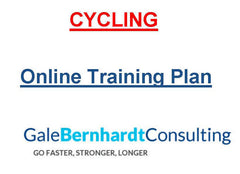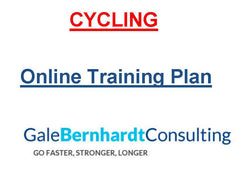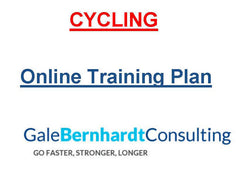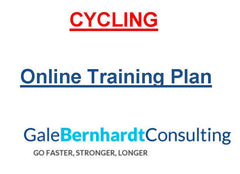Description
Cycling: Century Bike Ride, Intermediate: 3.25 to 9.25 hrs/wk, 16 wks
Author: Gale Bernhardt
16 weeks - $64.95 (There is a 10% discount when ordering from Gale Bernhardt’s website.)
Total Hours: 101
This 16-week training plan is designed for the rider looking average around 16 or 18 miles per hour for a century ride. A strength training program is included in the plan. For the first eight weeks of the plan, strength training occurs twice per week. Beginning in Week 9, strength training is reduced to maintenance at once per week. Should you decide not to strength train, for whatever reason, simply ignore or delete the strength training workouts.
Weekday bike rides are between 30- and 60-minutes long with a few options for 75-minute rides. The last eight weeks of the plan includes muscular endurance intervals to improve speed at threshold. This training is more intense than the training in the beginner plan. Long training rides begin at 1:15 in Week 1and build to between 5:00 and 5:30 in Week 14. Training ranges from 3:15 to 9:15 per week, with one to three days off each week for recovery and other lifestyle activities. The plan includes a taper designed to improve average speed on event day.
You can find more information on intensity levels behind the Supporting Documents link. You will also get a downloadable file of these supporting documents after purchase.
Prepare well, ride fast, have fun ~
Q – What do I get with a training plan?
A – After purchase, you will receive an email with instructions on how to download and access your training plan. Your plan will be available in your own private online training log account. You will enjoy the following benefits and more:
- Daily e-mails with your next workout keep you on track
- Create your own routes or search the library of routes for tracking your workouts
- Map, graph and share workouts with your friends by e-mail, Facebook and view in Google Maps or Google Earth
- Upload workouts from one of more than 80 training devices (Garmin, Suunto, Timex, Polar, more) or easily record your workouts manually
- Track your fitness and gain confidence
- Complete nutrition tracking to monitor your diet
- Get support and answers on a message board specific to your plan and access to more message boards

Q – What if I don’t like the plan once I’ve seen it?
A – Because discounted plans are offered through this site and a coding system, no refunds are allowed. If you are worried about wanting or needing a refund, you can forgo the discount and purchase the plan directly from the TrainingPeaks website. Refunds for training plans are offered for a limited time after purchase. You can find this training plan on that site by following this link.
Sample workouts:
Workout #1 : Strength
Planned Time: 1:00:00
Warm up aerobically, running or cycling for 10-20 minutes, then complete 2-3 sets x 15-20 repetitions (reps) of the designated exercises using a light to moderate weight.
Workout #2 : Bike
Planned Time: 0:30:00
This workout is intended to work on pedaling form and neuromuscular coordination. Most of the workout is in Zones 1-2. Relaxed form is more important than driving a high heart rate. On an indoor trainer: Warm up with low resistance and a pedaling cadence of 90 rpm. After 15 to 20 minutes of warm-up, increase cadence to 100 rpm for 3 minutes, 110 rpm for 2 minutes and 120+ rpm for 1 minute. If time allows, spin easy for 5 minutes to recover and repeat a second time. If just beginning to increase pedaling speed, it may be best to cut all of the times in half, in order to maintain the recommended speeds. It is important the resistance is low, to allow a focus on speed of the feet and not force on the pedals. This workout can be done on the road, if the road is flat or slightly downhill.
Workout #3 : Bike
Planned Time: 0:45:00
This workout helps work the dead spot out of pedal stroke. After a warm-up, with light resistance on an indoor trainer, do 100 percent of the work with one leg while the other leg is or resting on a stool. The bottom of the stroke is similar to the motion of scraping mud off the bottom of your shoe. The top of the stroke can be improved by driving toes forward. In all positions, keep the toes relaxed. Do not allow them to curl-up and clinch the bottom of your shoe. (This can be done outdoors by relaxing one leg while the other leg does most of the work.) After doing a work segment with each leg (start with 20-60 seconds per leg), spin easy with both legs for 1-3 minutes and then go back to single legwork. Begin with a cumulative time of 3 to 5 minutes on each leg and build time, as you become stronger.
Workout #4 : Day Off
Planned Time: 0:00:00
Relax
Workout #5 : Bike
Planned Time: 1:00:00
This level is used for aerobic maintenance and endurance training. Heart rate should stay primarily in Zones 1 to 2. How much time is spent in each zone depends on how you feel that day. The goal of an E2 ride is not to see how much time you can spend in Zone 2. Ride on a rolling course if possible, with grades up to 4 percent. For reference, most highway off-ramps are 4-percent grade. Riding in a slightly larger gear can simulate a gentle hill, if there are no hills where you live. Remain in the saddle on the hills. If you ride with a group, inner discipline is necessary to let the group go if they want to hammer.
Workout #6 : Bike
Planned Time: 1:00:00
To estimate lactate threshold heart rate, you’ll complete an individual time trial. After a good warm-up, start your monitor and time trial as fast as possible for 20 minutes. This means metering your speed so you can produce the highest average, best effort for the full 20 minutes. (Read: Avoid a fast 5-minute effort then a slow fade.) Collect your heart rate average for the time trial and divide this value by 1.02. For example, if your average heart rate for the 20-minute time trial was 170, then threshold heart rate can be estimated by 170 divided by 1.02 or a value of 167. Record how you felt and course conditions in your journal.
Workout #7 : Bike
Planned Time: 1:15:00
This level is used for aerobic maintenance and endurance training. Heart rate should stay primarily in Zones 1 to 2. How much time is spent in each zone depends on how you feel that day. The goal of an E2 ride is not to see how much time you can spend in Zone 2. Ride on a rolling course if possible, with grades up to 4 percent. For reference, most highway off-ramps are 4-percent grade. Riding in a slightly larger gear can simulate a gentle hill, if there are no hills where you live. Remain in the saddle on the hills. If you ride with a group, inner discipline is necessary to let the group go if they want to hammer.
Workout #8 : Strength
Planned Time: 1:00:00
Warm up aerobically, running or cycling for 10-20 minutes, then complete 2-3 sets x 15-20 repetitions (reps) of the designated exercises using a light to moderate weight.
Workout #9 : Bike
Planned Time: 0:45:00
This workout helps work the dead spot out of pedal stroke. After a warm-up, with light resistance on an indoor trainer, do 100 percent of the work with one leg while the other leg is or resting on a stool. The bottom of the stroke is similar to the motion of scraping mud off the bottom of your shoe. The top of the stroke can be improved by driving toes forward. In all positions, keep the toes relaxed. Do not allow them to curl-up and clinch the bottom of your shoe. (This can be done outdoors by relaxing one leg while the other leg does most of the work.) After doing a work segment with each leg (start with 20-60 seconds per leg), spin easy with both legs for 1-3 minutes and then go back to single legwork. Begin with a cumulative time of 3 to 5 minutes on each leg and build time, as you become stronger.




